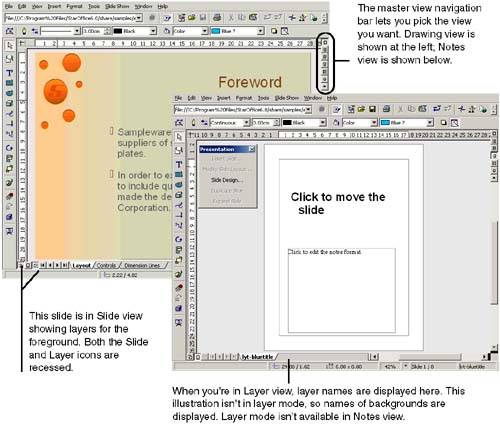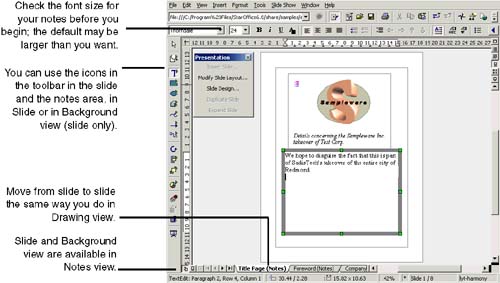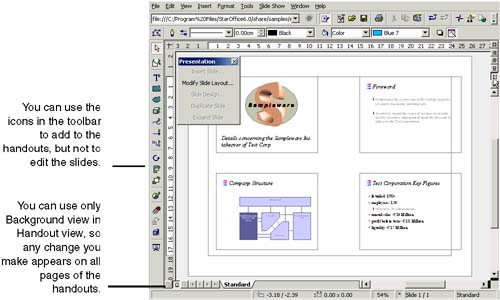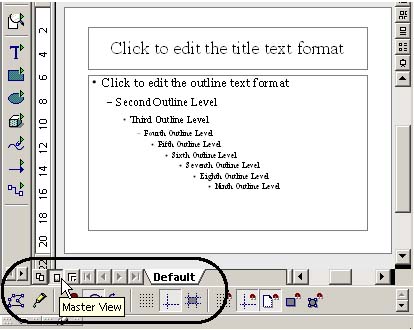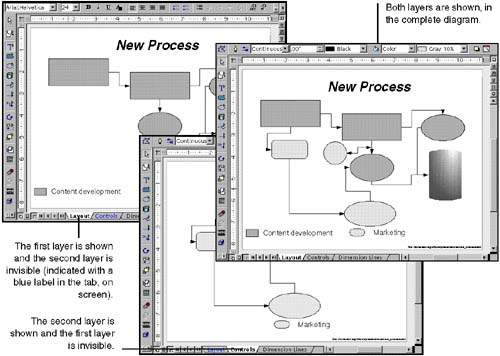Using Master Views, ForegroundBackground Views, and Layers
Using Master Views, Foreground/Background Views, and LayersReview this overview section before you continue to the next chapter, so that you know how to get to the part of your presentation that you need, and view it the way you want to. You can think of Impress as three-dimensional in its display and editing capabilities. It has three different systems to show different aspects of your presentation: master views, foreground/background views, and layers. It's a good idea to get to know them now, because it can make finding your way through a presentation and getting to the parts you need to edit a lot less frustrating. Orientation to Each View or ModeOverview of drawing, outline, slide, notes, and handouts master viewsShow different parts of your presentation, such as only the handouts, or only the slide, as well as different displays: one slide at a time or all at once. The Master views are Drawing, Outline, Slide, Notes, and Handout and are always accessible at the right side of the presentation work area at the top. Figure 25-12 shows a more extensive example; you can learn how to use them in Using Master Views on page 653. Figure 25-12. Master views, foreground/background views, and layers Overview of foreground/background views, in icons at the bottom of the work areaThese let you work with the main content of your presentation (content such as charts and text, in Slide view) or the background (page design, in Background view) of your presentation. See Figure 25-9. Figure 25-12 shows a more extensive example; you can learn how to use them in Using Foreground/Background Views on page 657. Figure 25-9. Background view (accessed by clicking the middle icon, Master View) Overview of layers: extra dimensions for slide foreground or backgroundLayers are something you can do anytime , whether you're seeing the foreground of your slide or the background. However, you can only do it when you're in the normal Drawing master view; there's not much point in having layers when you're just viewing an outline of the presentation in Outline master view, for instance. Layers are similar to the illustrations in anatomy books, with each layer belonging to a different system: the skeletal system, the digestive system, and so on. Layers let you separate items in one slide into separate groups.
See Figure 25-10. Layout, Controls, and Dimension Lines are three default layers.
Figure 25-10. The default layers for a slide Figure 25-11. Recognizing when you're seeing layers in background view, and just seeing the names of your backgrounds, in background view. Figure 25-12 shows a more extensive example; you can learn how to use them in Using Layers on page 659. Figure 25-12 shows aspects of master views, foreground/background views, and layers. Using Master ViewsDisplaying all the elements of a presentationslides, notes, structure, and so onwould be visually dizzying and logistically difficult. Impress has divided the ways you can look at your presentation into five master views : Drawing, Outline, Slide, Notes, and Handout. Changing From One View to AnotherTo get to a particular view, use the view bar at the right side of the work area. Note that the bottom icon, Start slide show, doesn't take you to a different view. It's easy to click this icon by accident . It starts the presentation, giving you a blank screen at first that is somewhat alarming if you don't expect it. To stop the presentation, just press Esc. Drawing ViewYou'll spend most of your time in the Drawing view, adding text and graphics. You have the same capabilities here as in Draw, with additional text and effects features. See Figure 25-12 on page 653 and Figure 25-1 on page 635 for examples of the Drawing view. Outline ViewThis view shows the outline of your presentation (Figure 25-13). You can expand and contract heading levels to view only top-level headings, all text, and everything in between, and reorganize the presentation. Figure 25-13. Outline view Slide ViewUse the Slide view (Figure 25-14) to get a bird's eye view of your presentation, to rearrange, add, and delete slides, and to specify how each slide changes to the next. Figure 25-14. Slide view The features on the toolbar are probably still unfamiliar to you at this point; the terms are presented here so that you can start getting oriented, and get to know the work area. All features, such as rehearsing timings and setting up transition types, are covered throughout the Impress chapters. Note Choose View > Toolbar > Presentation to display the Presentation menu, which shows the selected effects. Notes ViewAdd speaker notes in this view (Figure 25-15), below the slide area. When you print, you can choose to print with or without the notes. (See Setting Printing Options on page 745.) Figure 25-15. Notes view You can use Draw tools to edit in this view. Handout ViewCreate audience materials out of the slides using this view (Figure 25-16). Figure 25-16. Handout view This view lets you specify the number of slides per page. What you see in the work area is what will be on each page of handouts given to people attending the presentation. You have access to Draw tools here, as well. You can drag and resize the slides manually. To set the number of slides per handout page, choose Format > Modify Layout. (The maximum per page is six.) Using Foreground/Background ViewsImpress has three additional views that let you see the foreground or background of a slide, as well as layers within each: Slide view, Background view, and Layer view.
They're available in only two of the master views.
Slide View: The ForegroundIn Slide view, you have all the Draw tools and can do the standard editing for developing the presentation. You'll spend much of your time in Drawing view and Slide view. The changes you make apply only to the current slide, even if you're changing items that belong to a design component used throughout the presentation. Background View: The BackgroundThis view lets you make changes to the background and related items. The page style (the background design) that you selected in AutoPilot or added yourself is shown in this view. Switch to it by clicking the middle icon in the lower left corner of the work area, as shown at right. Layer ModeYou can divide the contents of the slide foreground or background into an unlimited number of layers .
Changing Between Foreground and Background, and Layer Mode For EachIt's intuitive, kind of. When you want "Background," think "Master." No, not as in Master View, but as in, somebody thought that Background was the same as Master when setting up the interface. Switching from foreground to backgroundChoose View > Master > and then the kind of view you want to see the background for. If you choose View > Master > Drawing, you'll get into the background view for the Drawing View. When you're in Drawing, Notes, or Handouts view, you can also click the icon shown in Figure 25-19. Figure 25-19. Navigating between foreground (slide) and background, and layers Switching to foreground viewChoose View > Slide. That will take you to the foreground of whatever view you were in the background for. Switching so you can see layersChoose View > Layer. This works in foreground or background, for Drawing master view or Notes master view. Using LayersWhen you're in Layer mode, you can use layers to separate parts of a slide so that each group can be edited and viewed by itself. Impress comes with default layers. The foreground has Layout (the default), Controls , and Dimension lines. The background has Background objects. For example, layers let you draw a new interdepartmental process with the parts for each department in a different layer. Figure 25-23 on page 660 shows how layers look. Figure 25-23. Layered diagram Layer Quick FactsYou can't delete or rename the default layers, but you can hide them or prevent them from being printed (see Controlling Whether a Layer Is Printable or Editable (Locked) on page 661). The default layers are provided with all slides; however any layer you add is specific to the slide you're in when you add it. You can use layers only when you're in the Drawing master view. Every layer is included in all slides in the presentation; there are no slide-specific layers. Layers are displayed from left to right and front to back: that is, the layer whose tab is displayed on the left side of the navigation bar is the top layer, and so on. Objects in the top layer will block the view of objects in the same position in subsequent layers. Creating a LayerThis will add a layer to the right of the Dimension Lines layer not to the right of the layer tab you select. You can't control where they are created. If you create two new layers, Layer4 and Layer5, Figure 25-20 is the result.
Figure 25-20. Order in which layers are inserted Changing LayersBe sure you're in Layer view. (See Using Foreground/Background Views on page 657.) Then click the tab for the layer you want, in the navigation bar at the bottom of the work area (Figure 25-22 on page 660). Figure 25-22. Working with layers Controlling Which Layer Is on TopThere isn't a way to explicitly reorder the layers; however, there are a few workarounds:
The default layer Controls is always on top. As for the other layers, the order in which you draw the objects controls what's on top: the first is on the bottom and last on the top, regardless of the layer. Changing the arrangements of the objects using the Arrange > Send to back and similar features doesn't change the relationship of objects in different layers, though it does change object relationships within a layer. Controlling Whether a Layer Is Printable or Editable (Locked)To protect elements of a layer from being changed, or to keep them from being printed, you can lock the layer.
Hiding One or More LayersThe layer view in Impress is a little unintuitive. If you have three layers and you click the tab of any of them, you still see all the objects in all layers. You can even edit one layer's objects when you've clicked the tab of another layer. To show only the objects of one layer, or of two, you have to hide the layers that you don't want to see.
Note Invisible layers' names always appear in blue. Renaming a Layer
Deleting a Layer and All Objects in ItThis deletes the layer and all objects in it, so move objects out of the layer before beginning if you want to preserve them. Also, remember that the layer will be deleted from all slides in the presentation.
Moving Objects Among LayersSurprisingly, you can't just cut and paste to move objects from one layer to another; you'll need to drag them instead. You'll need to make sure the tabs of both layers can be displayed simultaneously , so widen the main program window if necessary, or follow the directions in step 3 when you get to it.
|
EAN: 2147483647
Pages: 407
